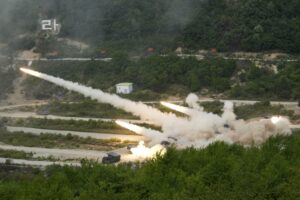
STUTTGART, Germany — France’s government is pouring hundreds of billions of euros into shoring up its military apparatus via its newest military programming law, which, if enacted, would support new capability efforts and ongoing programs through the end of the decade.
Officials unveiled the proposed 2024-2030 military programming law (LPM) on April 4, ahead of presenting it to France’s legislative bodies. The five-year programming law has been in development since spring 2022, and was honed during top-level meetings with French President Emmanuel Macron, Prime Minister Elisabeth Borne, and Defense Minister Sebastien Lecornu, said Army Col. Yann Latil, director of the ministry’s strategic capability cell, during an April 3 media briefing.
In January, Macron first announced that the LPM would include €400 billion ($435 billion) in investments, and cover a total of €413 ($450) billion in military needs. The investments are intended to target several areas of focus, to include a need for additional munitions and weaponry in the wake of Russia’s attack on Ukraine and a return to high intensity conflict on the European continent. Officials also cited increasing tensions in the Indo-Pacific region, and the increasingly speedy pace of technology innovation as incentives for the priorities set in this programming law.
The ministry plans to request an additional €1.5 billion be added to the 2023 annual defense budget, bringing it from €43.9 billion to about €45.4 billion. The annual budgets would then increase year over year by at least €3 billion through 2030, said François Bolard, the ministry’s budget adviser.
Specifically, the budget will increase by €3.1 billion in the 2024 budget; by €3 billion in 2025, 2026, and 2027, and by €4.3 billion in 2028, 2029, and 2030, he told reporters. By 2030, France’s annual defense budget is expected to top €60 billion; nearly double the amount allocated in 2017 of €32 billion, he added.
Over the course of the next five years, the French military is both continuing ongoing capability reboots and launching new initiatives.
The development of the nation’s next-generation aircraft carrier, dubbed PANG for the French porte-avion nouvelle generation, will kick into high gear, with plans to put the Naval Group-built carrier to sea in 2036-2037, and begin trials in 2037-2038, officials said. Also in the maritime domain, France is scheduled to receive 15 new frigates by 2030, including three new FDI models meant for defense and intervention.
France’s air force will see the entry of the MBDA-developed, renovated medium range air-to-surface (ASMPA-R) missile during this budget cycle, as well as the development of its expected successor, the fourth-generation nuclear air-to-ground (ASN4G) hypersonic cruise missile that will succeed it. ArianeGroup is on contract to develop and manufacture the new missile.
Paris will continue its timeline to achieve an “all Rafale” air fleet by 2035, and expects to procure 32 new fighter jets from contractor Dassault Aviation within the LPM, which will be delivered between 2030 and 2032, officials said. The Future Combat Air System (FCAS) next-generation fighter and weapon program in development by France, Spain, and Germany, should see its first fighter demonstrator come to fruition under this LPM, in 2027.
The French military will also continue to modernize its land forces via the mammoth “Scorpion” overhaul program of its ground vehicles and associated equipment. Studies on the design for the Franco-German Main Ground Combat System (MGCS) next-generation tank will continue in the time period, officials said.
In the space domain, France plans to launch a new orbital space surveillance project, using nanosatellites to patrol Geostationary Orbit (GEO), identify potential on-orbit threats to national assets, and if necessary, disable the threat with an on-board laser
In partnership with the national space center CNES, the Air and Space Force intends to launch a demonstrator nanosatellite in 2023 under the “Yoda” project, with the system in development by contractor Hemeria. By 2030, a mature capability dubbed “Egide” would take on the “patrolling satellite” mission, the officials said.
The on-orbit laser is being developed under the “FLAMHE” project moniker. France is also anticipating developing a ground-to-space laser system dubbed BLOOMLASE, with both capabilities to be operational by the end of the decade.
While undersea warfare has become a major topic in France since former Defense Minister Florence Parly released the first undersea strategy in early 2022, ministry officials could not provide a fixed funding number for investments in the domain. They said only that it would be in the “hundreds of millions” of euros, and include investments in underwater drones that can reach 6,000 meters of depth, other types of undersea and subsea remotely operated vehicles, and upgrades to anti-mine vessels.
A report issued Monday by the French Ministry of Defense detailed the following planned investments:
- €5 billion for intelligence and counterintelligence efforts;
- €13 billion for overseas capabilities and initiatives;
- €5 billion for “drones,” to include unmanned systems and remotely operated munitions, as well as development on the Eurodrone medium-altitude, long-endurance UAV in development by Airbus for France, Spain, Germany, and Spain.
- €5 billion for surface-to-air defense capabilities;
- €16 billion for munitions, including the modernization of long-range anti-ship missiles, as well as F321 heavy torpedoes and new surface-to-air and air-to-air interceptors (MBDA’s Aster-MICA and METEOR families, respectively);
- €49 billion for maintenance and conditional operations, a 49% increase over the previous LPM;
- €10 billion for innovative technology investments, to include directed energy technology, swarming drones, and robotic capabilities;
- €6 billion for the space domain;
- €4 billion for cyber defense.
The €400 billion investments outlined in this programming law do not include any military support France might provide to Ukraine in the future, officials told reporters. “The Ukraine support is something that could evolve in time, and the president wanted to guarantee the evolution of this support could never impact our own capability buildup,” Bolard said. The bulk of France’s support to Ukraine would come via the European Union’s off-book European Peace Facility (EPF) funding mechanism, but officials did not share how much funding has been allocated to aid to Ukraine to date.
The French administration hopes the LPM will be voted on by Congress before the July 14th holiday, Bolard said.
Vivienne Machi is a reporter based in Stuttgart, Germany, contributing to Defense News' European coverage. She previously reported for National Defense Magazine, Defense Daily, Via Satellite, Foreign Policy and the Dayton Daily News. She was named the Defence Media Awards' best young defense journalist in 2020.
- SEO Powered Content & PR Distribution. Get Amplified Today.
- Platoblockchain. Web3 Metaverse Intelligence. Knowledge Amplified. Access Here.
- Source: https://www.defensenews.com/global/europe/2023/04/04/macron-sends-438-billion-military-budget-plan-to-french-parliament/
- :is
- $UP
- 000
- 1
- 2017
- 2020
- 2022
- 2023
- 2024
- 70
- 9
- a
- About
- Achieve
- added
- Additional
- administration
- ahead
- Aid
- AIR
- Air Force
- air-to-air
- Airbus
- aircraft
- allocated
- amount
- and
- announced
- annual
- anticipating
- April
- ARE
- areas
- Army
- AS
- Assets
- associated
- At
- attack
- aviation
- awards
- based
- BE
- become
- before
- begin
- being
- BEST
- between
- Billion
- billions
- Briefing
- Bringing
- budget
- Budgets
- by
- CAN
- capabilities
- Center
- cited
- combat
- come
- conflict
- Congress
- continent
- continue
- continuing
- contract
- Contractor
- contributing
- could
- course
- cover
- coverage
- cruise
- cyber
- cycle
- daily
- Daily news
- Date
- decade
- defence
- Defense
- delivered
- depth
- Design
- detailed
- develop
- developed
- developing
- Development
- DID
- Director
- domain
- double
- Drones
- dubbed
- during
- Early
- efforts
- Emmanuel Macron
- energy
- entry
- equipment
- European
- Euros
- evolution
- evolve
- expected
- expects
- Facility
- families
- First
- fixed
- FLEET
- Focus
- following
- For
- Force
- Forces
- foreign
- foreign policy
- Former
- France
- French
- French Parliament
- from
- fruition
- funding
- future
- Gear
- Germany
- Government
- Ground
- guarantee
- heavy
- High
- Holiday
- hopes
- How
- HTTPS
- Hundreds
- identify
- images
- Impact
- in
- Incentives
- include
- Including
- Increase
- increasing
- increasingly
- initiatives
- Innovation
- innovative
- innovative technology
- Intelligence
- intends
- intervention
- Investments
- Issued
- IT
- ITS
- January
- Jets
- journalist
- jpg
- July
- kick
- Land
- laser
- launch
- launching
- Law
- Legislative
- magazine
- Main
- maintenance
- major
- Maritime
- mature
- mechanism
- Media
- medium
- meetings
- might
- Military
- ministry
- missiles
- Mission
- models
- modernization
- modernize
- Monday
- Named
- National
- Nations
- nearly
- necessary
- Need
- needs
- New
- Newest
- news
- next
- next-generation
- nuclear
- number
- of
- on
- ongoing
- operated
- operational
- Operations
- Orbit
- Other
- outlined
- Overhaul
- overseas
- own
- Pace
- parliament
- Partnership
- period
- plan
- planned
- plans
- plato
- Plato Data Intelligence
- PlatoData
- policy
- potential
- president
- previous
- previously
- Prime
- prime minister
- Program
- Programming
- Programs
- project
- proposed
- provide
- put
- range
- reach
- receive
- region
- released
- report
- Reported
- reporter
- request
- respectively
- return
- Said
- satellite
- scheduled
- SEA
- set
- several
- Share
- should
- since
- something
- Space
- Space Force
- Spain
- spring
- Strategic
- Strategy
- studies
- succeed
- support
- surveillance
- system
- Systems
- Take
- tank
- Target
- Technology
- technology innovation
- that
- The
- The Future
- threat
- threats
- three
- Through
- time
- timeline
- to
- top
- top-level
- topic
- Total
- trials
- types
- UAV
- Ukraine
- under
- underwater
- unveiled
- upgrades
- Vehicles
- via
- voted
- Wake
- wanted
- WELL
- which
- will
- with
- within
- would
- year
- years
- young
- zephyrnet












